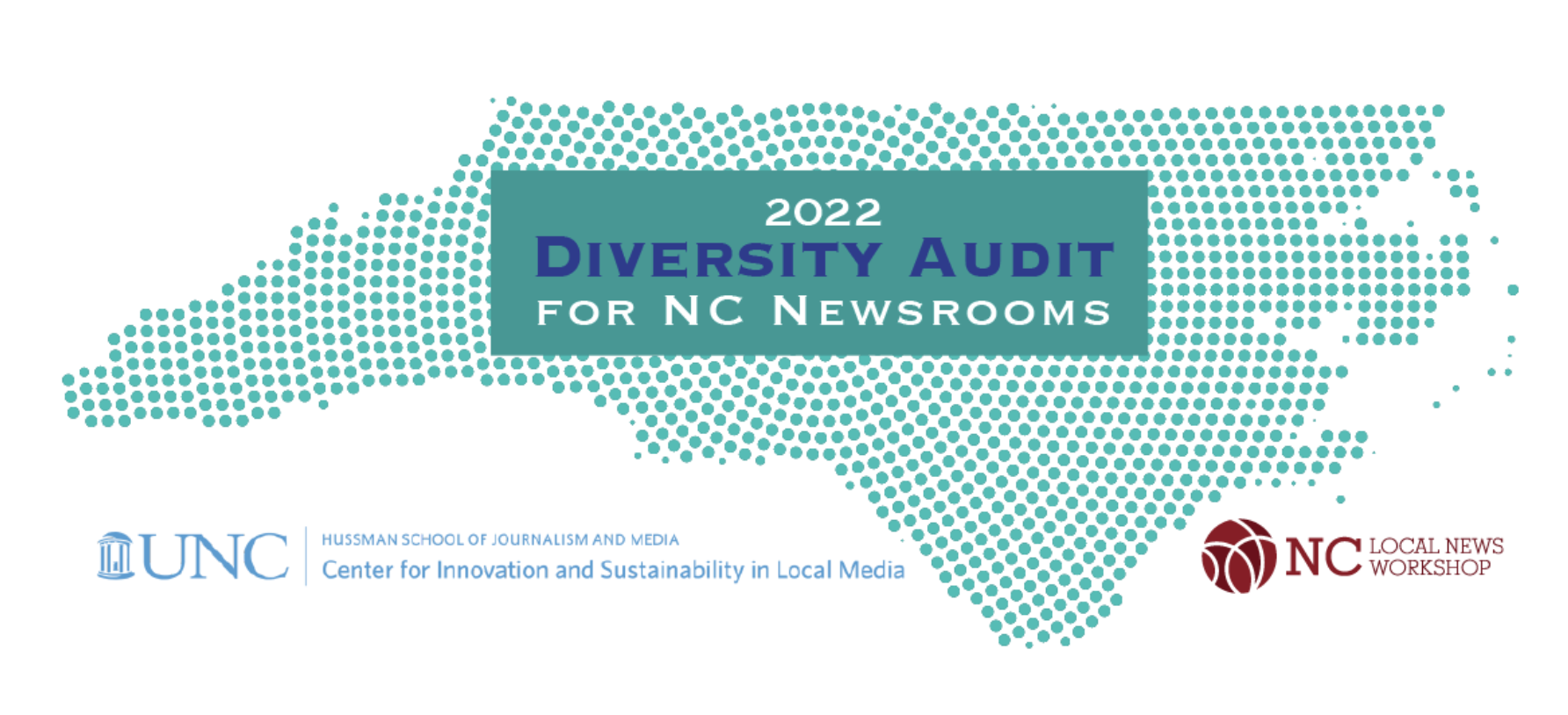This column highlights the 2022 Diversity Audit for NC Newsrooms, a partnership between the NC Local News Workshop and UNC’s Center for Innovation and Sustainability in Local Media. You can view the full research report and analysis here.
By Shannan Bowen and Erica Perel
Getting newsrooms to fill out surveys about the demographic makeup of their staff is about as hard at the state level as it has proven nationally. That’s one thing we learned in 2022, as our two centers set out to map the diversity of North Carolina’s newsrooms and compare it to the demographics of a changing, dynamic state.
But it’s far from the only thing we learned. The Diversity Audit of NC Newsrooms sent us on a project of discovery this year, and at the end, it has yielded information that will help us serve journalists, communities and newsrooms next year and beyond.
First, a few headlines.
Our research team compiled a list of more than 428 media organizations with newsrooms or news functions. Of the organizations we counted, 36 publishers participated in our survey about their organization. We also launched a survey for individuals of any organization or employment status, including freelancers. Participants of that survey included 152 people from 59 newsrooms across the state. Top findings included:
- The 36 participating newsrooms reported a total of 633 staff members, including 111 staff in leadership roles.
- About 70% of staff in participating newsrooms were white, consistent with similar surveys of newsrooms. Nearly a quarter of staff and 18% of leadership in participating newsrooms were Black.
- Women were 52% of staff in participating newsrooms, a higher proportion than in the 2019 News Leaders Association survey. Women and men make up equal shares of leadership at participating news organizations at 49% each.
- Half of individual survey respondents started their current position within the past three years.
- More than 40% of respondents working at news organizations earn less than $50,000 per year, the approximate threshold of the North Carolina Budget and Tax Center’s Living Income Standard for one adult and one child.
- 30% of respondents said they had some kind of disability, but only a few had sought accommodations under the Americans with Disabilities Act, revealing a need for newsrooms to support their disabled staff.
While the participating newsroom’s staff numbers included hundreds of journalists, neither survey yielded enough participation for us to draw generalized conclusions about the data. This makes us unable to meaningfully compare the survey results to North Carolina’s demographic data from the 2020 Census.
Three of the state’s largest corporate-owned newsrooms (The News & Observer, The Charlotte Observer and WRAL) participated in the survey and their contributions added greatly to the understanding we now have of our state’s journalism workforce. But by and large, properties owned by corporate chains did not participate, despite direct outreach and reminders. In some cases, centralized record-keeping prevented local staff from accessing the data, and efforts to reach out to central offices directly bore little fruit.
The rural-urban divide in North Carolina was deeply reflected in results. More than 60 percent of organizational survey respondents are located in just four of 100 counties, and 55 percent of the journalists represented in the organizational survey worked in a single NC county—Wake.
Some Background
We started the year with a few hypotheses. First: a lack of representation in newsrooms leads to distrust, low engagement and, over time, less informed communities overall. We assumed that our state’s newsrooms are led by mostly white men and women and that their staffs lack the racial and ethnic diversity of the communities they seek to serve.
In our view, the representation problems are systemic and complex. The solutions must seek to change newsroom policy and practice.
The NC Local News Workshop launched the NC Media Equity Project in 2020 to help newsrooms learn and practice initiatives that progress their diversity, equity, inclusion and belonging goals. In the first year of the program, six of NC’s largest newsrooms convened to discuss shared challenges specific to working in NC and to receive coaching on their individual goals. For 2022, the Media Equity Project’s focus was on retention and leadership development of journalists of color, as well as widening the talent pipeline.
But something was missing. We lacked the data to know the benchmarks and understand where to focus further efforts, and our two centers decided to partner on a statewide effort to survey newsrooms.
We were certainly aware of the challenges. But we also wanted to try this at the state level to take advantage of NC’s deeply networked journalism ecosystem. We believed the results would help us to better understand our statewide media ecosystem in a way that would lead to action and continued change.
The Audit Analysts
Early in the survey promotion phase, journalist Laura Brache suggested including people of color and other underrepresented groups in the project, as the leadership and research staff of our two centers are made up of white women. We convened a panel of analysts, comprised of people of color, to review the data and write a memo about findings and recommendations.
Their takeaways ranged from reflection about the type of news organizations that prioritize DEIB to what newsrooms need to do to better support people with specific needs. This resulted in a few important themes from our research findings:
Retention and Promotion of Diverse Leaders
“As a woman, it was alarming to see so few women (15%) identify themselves as being in a position of leadership and only a few more (17%) say they had been promoted into their current position,” wrote analyst Cierra Brown Hinton, who leads the southern publication Scalawag. “When I think about my intersecting identities this is even more alarming because we know that the more marginalized identities you hold, it’s likely that your experience is statistically worse. If the future of news includes women and femme folks we have to do more to make their leadership viable and careers sustainable.”
Hinton suggested providing professional development and career training opportunities with the intention of investing in and retaining women and femme folks in the newsroom. “Show all staff, but especially women and femme folks, that you are invested in their development,” she wrote in her analysis. “Provide resources, access, and time for conferences, fellowship programs and other trainings. Check norms and practices that prohibit or inhibit their success.”
Cultural Transformation and Prioritizing DEIB
Brache, another analyst who is also a reporter for the News & Observer, suggested that newsrooms make DEIB part of their company’s strategic plan, and also part of employees’ annual goals.
“Requiring employees to have a DEIB goal, regardless of their role, is another way to ensure everyone in the company is being held accountable for making the newsroom a place for everyone,” she wrote.
Developing NC’s Talent Pipeline
Hiring, promotion and retention was a topic discussed by nearly every analyst.
Analyst Tony Elkins, a product director for Gannett, advised that newsrooms should “not ask diverse people in your own network to send you candidates.” Instead, he said hiring managers should work on building their own connections with schools and associations. “It’s important that the work of bringing in diverse candidates not be the role of diverse staff,” he wrote.
Brache pointed out that it was obvious from the survey results that newsrooms are not hiring enough people who are Hispanic or Latino: “Considering North Carolina is the state with the fastest-growing Hispanic/Latino population in the U.S., newsrooms are completely missing the mark in making sure this community is represented in their newsrooms, especially if their non-Hispanic/Latino employees do not fluently speak Spanish or other languages and dialects of Latin American Indigenous peoples,” she wrote.
Recruiting applicants is not the only step. Low pay in an era of inflation is a barrier to hiring, retention and promotion of talented journalists who reflect the state’s diversity. More than 40 percent of the individual survey responses reported earning less than $50,000 per year.
Eileen Rodriquez, who works as a reporter for public radio station WFFD, suggested in her analysis that though competitive pay for new journalists might not be available at first, other perks could help them grow and develop instead of pass up on an opportunity. One way to do this, she advised, is to create and flag mentorship opportunities for young journalists. “Get them introduced to older journalists that could provide mentorship and/or one-on-one training to new journalists,” she said. “While on the job, upward mobility is harder for queer (and) women journalists of color.”
Accountability and Auditing as a Practice
“Perhaps one of the most tangible results of this initiative was the practice of auditing,” said analyst Adriana Chavela, who leads Hola Carolina. “This survey was an audit of newsroom composition. Critically, a source audit is needed to identify change in culture, and a shift in journalistic practices. To make diversity count, we must keep a count. Knowing who your audience is, and representing the diversity of that audience is critical.”
But many organizations don’t track source diversity—especially without being asked to do so.
“There are several causes of concern in the initial finding. The first being the lack of participation, or reporting, from some of the state’s largest journalism employers in newspapers, digital media, television and radio),” Elkins said. “This is a potential signal these companies may outwardly support diversity efforts, but are not putting in the work, or transparency, to make substantial change. The findings also highlight a large divide (in responses) between traditional print companies and broadcasting (television). With journalism resources and positions contracting, it’s important (that) a concerted effort across all platforms make a commitment to filling positions with more diverse candidates.”
Hinton said that as a Black media leader herself, she was disheartened to see the lack of participation from white media leaders. She said “the outsized participation in DEIB efforts by people of color and lack of participation from white folks is in alignment with what is generally true. This is definitely a trend to keep an eye on as more intentionality is put into efforts to bolster participation in the audit. For now, we know Black leaders did show up as we generally do.”
Where We Go From Here
We aim to share lessons learned with other ecosystem-building organizations in hope that they’re inspired to conduct statewide diversity audits such as this.
Our organizations have plans to apply the findings from this year’s audit to our future work. The NC Local News Workshop, for example, will implement some of the analysts’ recommendations in the ongoing NC Media Equity Project next year. And we’ll each work with organizations in our state by providing coaching and resources to help them move the needle on their DEIB goals.
“The demographics of the U.S. are rapidly changing. Those organizations that remain immobile in profound structural change run the potential of being left behind,” Dr. Kaia Shivers wrote in her analysis.
“Many organizations have existed in such strict boundaries that often where to start in peeling back years of implicit biases will take years of concerted effort that must incorporate in full, the communities they report on. In particular, the state’s past of generations of discriminatory practices also must be remedied in news agencies. While North Carolina is at a crossroads, its newsrooms can be a template of progress.”
View the full report here.




